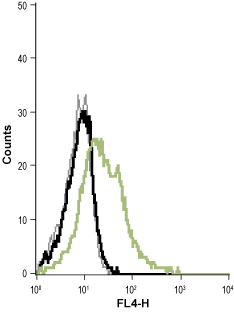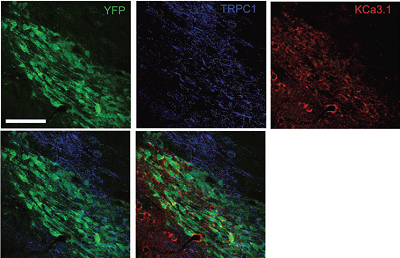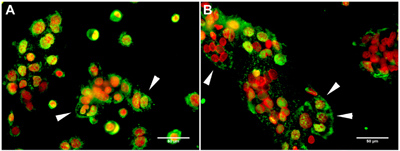Overview
- Synthetic peptide mapping to the 3rd extracellular loop of human KCNN4 (Accession O15554).

 Western blot analysis using Mouse Anti-KCNN4 (KCa3.1, SK4) (extracellular) Antibody (#ALM-051), (1:250):1. HEK cells transfected with control vector.
Western blot analysis using Mouse Anti-KCNN4 (KCa3.1, SK4) (extracellular) Antibody (#ALM-051), (1:250):1. HEK cells transfected with control vector.
2. HEK cells transfected with human KCa3.1. Western blot analysis using Mouse Anti-KCNN4 (KCa3.1, SK4) (extracellular) Antibody (#ALM-051), (1:250):1. Mouse MS1 endothelial cells.
Western blot analysis using Mouse Anti-KCNN4 (KCa3.1, SK4) (extracellular) Antibody (#ALM-051), (1:250):1. Mouse MS1 endothelial cells.
2. Rat IEC-6 intestinal epithelial cells.
3. Human LN-CaP prostate carcinoma cells.
4. Human THP-1 acute monocytic leukemia cells.
 Multiplex staining of KCa3.1 (SK4) and TRPC1 in mouse brainImmunohistochemical staining of mouse brain sections using Mouse Anti-KCNN4 (KCa3.1, SK4) (extracellular) Antibody (#ALM-051) and Anti-TRPC1 Antibody (#ACC-010). TRPC1 staining (blue) is detected in neuroblasts and outside neuroblasts as well (in astrocytes). KCa3.1 (red) is detected in neuroblasts. Merged image demonstrates the partial co-localization between the two.
Multiplex staining of KCa3.1 (SK4) and TRPC1 in mouse brainImmunohistochemical staining of mouse brain sections using Mouse Anti-KCNN4 (KCa3.1, SK4) (extracellular) Antibody (#ALM-051) and Anti-TRPC1 Antibody (#ACC-010). TRPC1 staining (blue) is detected in neuroblasts and outside neuroblasts as well (in astrocytes). KCa3.1 (red) is detected in neuroblasts. Merged image demonstrates the partial co-localization between the two.
Adapted from Turner, K.L. et al. (2014) Cereb. Cortex. 24, 2388. with permission of Oxford University Press.
 Cell surface detection of KCa3.1 (SK4) in live intact Raji (human Burkitt's lymphoma B cells) cell line:___ Cells + goat-anti-mouse-Cy5.
Cell surface detection of KCa3.1 (SK4) in live intact Raji (human Burkitt's lymphoma B cells) cell line:___ Cells + goat-anti-mouse-Cy5.
___ Cells + mouse IgM isotype control + goat-anti-mouse-Cy5.
___ Cells + Mouse Anti-KCNN4 (KCa3.1, SK4) (extracellular) Antibody (#ALM-051), (1:20) + goat-anti-mouse-Cy5. Cell surface detection of KCa3.1 (SK4) in live intact THP-1 (human acute monocytic leukemia cells) cell line:___ Cells + Goat-anti-mouse-Cy5.
Cell surface detection of KCa3.1 (SK4) in live intact THP-1 (human acute monocytic leukemia cells) cell line:___ Cells + Goat-anti-mouse-Cy5.
___ Cells + Mouse IgM isotype control+ Goat-anti-mouse-Cy5.
___ Cells + Mouse Anti-KCNN4 (KCa3.1, SK4) (extracellular) Antibody (#ALM-051), (1:20) + Goat-anti-mouse-Cy5.
 Expression of KCNN4 in live intact human LN-CaP prostate carcinoma cellsCell surface detection of KCNN4 in live intact human LN-CaP prostate carcinoma cells with Mouse Anti-KCNN4 (KCa3.1, SK4) (extracellular) Antibody (#ALM-051) (1:20), followed by goat-anti-mouse-DyLight-594 secondary antibody (red) (A). B. Live view of the cells. C. Merge of the two images.
Expression of KCNN4 in live intact human LN-CaP prostate carcinoma cellsCell surface detection of KCNN4 in live intact human LN-CaP prostate carcinoma cells with Mouse Anti-KCNN4 (KCa3.1, SK4) (extracellular) Antibody (#ALM-051) (1:20), followed by goat-anti-mouse-DyLight-594 secondary antibody (red) (A). B. Live view of the cells. C. Merge of the two images.
- Ghanshani, S. et al. (2000) J. Biol. Chem. 275, 37137.
- Hoffman, J.F. et al. (2003) Proc. Natl. Acad. Sci. U.S.A. 100, 7366.
KCa3.1 (KCNN4, SK4) is a member of the Ca2+ activated K+ channel family that shares the characteristic of being activated by intracellular Ca2+. The channel has an intermediate conductance, is voltage insensitive and is activated by Ca2+ in the submicromolar range. The channel has a similar topology to that of KV channels, that is, six transmembrane domains and intracellular N- and C-termini.
KCa3.1 is widely expressed in epithelial, endothelial and cells of hematopoietic origin. In erythrocytes (red blood cells) it has been identified as the molecular correlate of the so-called Gardos channel.
The functional role of the channel is to set the cell membrane potential at negative values so as to aid in the electrochemical transport of other ions such as Cl- and Ca2+. Indeed, KCa3.1 has a key role in sustaining the Ca2+ influx in activated T lymphocytes and in regulating Cl- secretion from colon epithelium. Therefore, specific blockers of the KCa3.1 channel have been proposed for the treatment of several diseases including autoimmune diseases, secretory diarrhea and sickle cell anemia.
Application key:
Species reactivity key:
Mouse Anti-KCNN4 (KCa3.1, SK4) (extracellular) Antibody (#ALM-051) is a highly specific monoclonal antibody directed against an epitope of the human channel. The antibody can be used in western blot, immunocytochemistry, immunohistochemistry, and indirect flow cytometry applications. It has been designed to recognize KCNN4 from human, rat, and mouse samples.
 Multiplex staining of KCa3.1 (SK4) and TRPC1 in mouse brainImmunohistochemical staining of mouse brain sections using Mouse Anti-KCNN4 (KCa3.1, SK4) (extracellular) Antibody (#ALM-051) and Anti-TRPC1 Antibody (#ACC-010). YFP denotes neuroblasts. TRPC1 staining (blue) is detected in neuroblasts and outside neuroblasts as well (in astrocytes). KCa3.1 (red) is detected in neuroblasts. Merged image of all three staining (lower right panel) demonstrates the partial co-localization between the three.Adapted from Turner, K.L. and Sontheimer, H. (2013) Cereb. Cortex 24, 2388. with permission of Oxford University Press.
Multiplex staining of KCa3.1 (SK4) and TRPC1 in mouse brainImmunohistochemical staining of mouse brain sections using Mouse Anti-KCNN4 (KCa3.1, SK4) (extracellular) Antibody (#ALM-051) and Anti-TRPC1 Antibody (#ACC-010). YFP denotes neuroblasts. TRPC1 staining (blue) is detected in neuroblasts and outside neuroblasts as well (in astrocytes). KCa3.1 (red) is detected in neuroblasts. Merged image of all three staining (lower right panel) demonstrates the partial co-localization between the three.Adapted from Turner, K.L. and Sontheimer, H. (2013) Cereb. Cortex 24, 2388. with permission of Oxford University Press.
Applications
Citations
 Multiplex staining of TRPV4 and KCa3.1 in human BSM cellsImmunocytochemical staining of human bronchial smooth muscle (HBSM) cells using Mouse Anti-KCNN4 (KCa3.1, SK4) (extracellular) Antibody (#ALM-051), (green) and Anti-TRPV4 Antibody (#ACC-034), (red).
Multiplex staining of TRPV4 and KCa3.1 in human BSM cellsImmunocytochemical staining of human bronchial smooth muscle (HBSM) cells using Mouse Anti-KCNN4 (KCa3.1, SK4) (extracellular) Antibody (#ALM-051), (green) and Anti-TRPV4 Antibody (#ACC-034), (red).
Adapted from Yu, Z. et al. (2017) Front. Pharmacol. 8, 559. with permission of Frontiers. Multiplex staining of KCa3.1 and P2Y2 in human ovarian carcinomaImmunohistochemical staining of human ovarian carcinoma biopsies using Mouse Anti-KCNN4 (KCa3.1, SK4) (extracellular) Antibody (#ALM-051) and rabbit Anti-P2Y2 Receptor Antibody (#APR-010). Positive co-expression is detected in ovarian neoplastic cells (merged image). Expression of KCa3.1 is also observed in stromal cells (*); however, P2Y2 does not co-localize with KCa3.1 in these cells.
Multiplex staining of KCa3.1 and P2Y2 in human ovarian carcinomaImmunohistochemical staining of human ovarian carcinoma biopsies using Mouse Anti-KCNN4 (KCa3.1, SK4) (extracellular) Antibody (#ALM-051) and rabbit Anti-P2Y2 Receptor Antibody (#APR-010). Positive co-expression is detected in ovarian neoplastic cells (merged image). Expression of KCa3.1 is also observed in stromal cells (*); however, P2Y2 does not co-localize with KCa3.1 in these cells.
Adapted from Robles-Martinez, L. et al. (2017) Sci. Rep. 7, 4340. with permission of Nature Publishing Group. Expression of KCNN4 channel in human cytotrophoblastsImmunocytochemical staining of human cytotrophoblast using Mouse Anti-KCNN4 (KCa3.1, SK4) (extracellular) Antibody (#ALM-051). A. Methanol fixed cells (15 hrs). B. Methanol fixed cells (66 hrs).
Expression of KCNN4 channel in human cytotrophoblastsImmunocytochemical staining of human cytotrophoblast using Mouse Anti-KCNN4 (KCa3.1, SK4) (extracellular) Antibody (#ALM-051). A. Methanol fixed cells (15 hrs). B. Methanol fixed cells (66 hrs).
Adapted from Diaz, P. et al. (2014) with kind permission of Dr. Diaz, P. and Dr. Greenwood, S.L. from Maternal and Fetal Health Research Centre, Institute of Human Development University of Manchester, Manchester, United Kingdom and St. Mary’s Hospital, Central Manchester University Hospitals National Health Service (NHS) Foundation Trust, Manchester Academic Health Science Centre, Manchester, United Kingdom. SK4 (KCNN4) channel is expressed in hESC-CMsImmunocytochemical staining of hESC-CMs. Cells were stained with Mouse Anti-KCNN4 (KCa3.1, SK4) (extracellular) Antibody (#ALM-051) followed by anti-mouse-Dylight405 secondary antibody (green). α-Actinin staining was used as a control (red). Upper panels are 18 days old beating clusters. Lower panels are dissociated hESC-CMs.
SK4 (KCNN4) channel is expressed in hESC-CMsImmunocytochemical staining of hESC-CMs. Cells were stained with Mouse Anti-KCNN4 (KCa3.1, SK4) (extracellular) Antibody (#ALM-051) followed by anti-mouse-Dylight405 secondary antibody (green). α-Actinin staining was used as a control (red). Upper panels are 18 days old beating clusters. Lower panels are dissociated hESC-CMs.
Adapted from Weisbrod, D. et al. (2013) Proc. Natl. Acad. Sci. U.S.A. 110, E1685. with permission of the National Academy of Sciences. Colocalization and expression of KCa3.1, ClC-3 and B2R in glioma cells.A-C. Immunocytochemical staining of human D54 glioma cells using Mouse Anti-KCNN4 (KCa3.1, SK4) (extracellular) Antibody (#ALM-051). KCa3.1, ClC-3 and B2R co-localize to the edges of cells. D. Western blot analysis of a number of glioma cells using Anti-CLC-3 (CLCN3) Antibody (#ACL-001) and Mouse Anti-KCNN4 (KCa3.1, SK4) (extracellular) Antibody.
Colocalization and expression of KCa3.1, ClC-3 and B2R in glioma cells.A-C. Immunocytochemical staining of human D54 glioma cells using Mouse Anti-KCNN4 (KCa3.1, SK4) (extracellular) Antibody (#ALM-051). KCa3.1, ClC-3 and B2R co-localize to the edges of cells. D. Western blot analysis of a number of glioma cells using Anti-CLC-3 (CLCN3) Antibody (#ACL-001) and Mouse Anti-KCNN4 (KCa3.1, SK4) (extracellular) Antibody.
Adapted from Cuddapah, V.A. et al. (2013) with permission of the Society for Neuroscience.
- Human ovarian cancer SKOV-3 cell lysates.
Robles-Martinez, L. et al. (2017) Sci. Rep. 7, 4340. - Human dendritic cells.
Crottes, D. et al. (2016) Cell Calcium 59, 198. - Mouse mesenteric arteries lysate.
Yap, F.C. et al. (2016) Am. J. Physiol. 310, H1151. - Mouse heart lysate (1:600).
Ju, C.H. et al. (2015) Cell. Physiol. Biochem. 36, 1305.
- Mouse CD4+ T-cells.
Srivastava, S. et al. (2016) eLife 19, 16093.
- Human ovarian tumor sections.
Robles-Martinez, L. et al. (2017) Sci. Rep. 7, 4340. - Mouse brain sections.
Turner, K.L. et al. (2014) Cereb. Cortex. 24, 2388.
- Human CD8+ T-cells.
Chimote, A.A. et al. (2020) Front. Pharmacol. 11, 143. - Human ovarian cancer SKOV-3 cells.
Robles-Martinez, L. et al. (2017) Sci. Rep. 7, 4340. - Human bronchial smooth muscle (HBSM) cells.
Yu, Z. et al. (2017) Front. Pharmacol. 8, 559. - Human dendritic cells.
Crottes, D. et al. (2016) Cell Calcium 59, 198. - Mouse CCDcl1 cells (1:100).
Li, Y. et al. (2016) PLoS ONE 11, e0155006. - Human cytotrophoblasts.
Diaz, P. et al. (2014) PLoS ONE 9, e90961.
- Yi, M. et al. (2017) J. Neuroinflammation 14, 203.
- Cuddapah, V.A. et al. (2013) J. Neurosci. 33, 1427.
- Weisbrod, D. et al. (2013) Proc. Natl. Acad. Sci. U.S.A. 110, E1685.
- Bagher, P. et al. (2012) Proc. Natl. Acad. Sci. U.S.A. 109, 18174.
